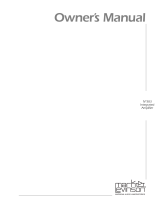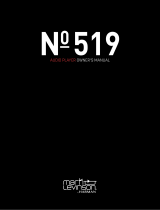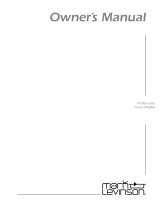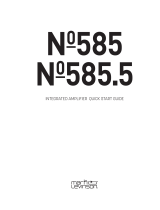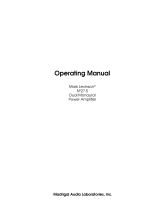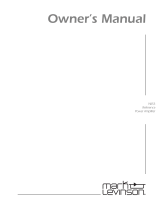Page is loading ...

Nº40
Media
Console
Owner’s Manual

i
1. Read these instructions
2. Keep these instructions.
3. Heed all warnings.
4. Follow all instructions.
5. Do not use this apparatus near water.
6. Clean only with a dry cloth.
7. Do not block ventilation openings. Install in accordance with the manufacturer’s instructions.
8. Do not install near any heat sources such as radiators, heat registers, stoves, or another apparatus
that produces heat.
9. Do not defeat the safety purpose of the polarized or grounding-type plug. A polarized plug has
two blades with one wider than the other. A grounding-type plug has two blades and a third
grounding prong. The wide blade or third prong is provided for safety. If the provided plug does
not fit into the outlet, consult an electrician for replacement of the obsolete outlet.
10. Protect the power cord from being walked on or pinched, particularly at plugs, convenience
receptacles, or the point where it exits from the apparatus.
11. Only use attachments and accessories specified by the manufacturer.
12. Use only with the cart, stand, tripod, bracket, or table specified by the manufacturer
or sold with the apparatus. When a cart is used, use caution when moving the cart/appa-
ratus combination to avoid injury or tip over.
13. Unplug this apparatus during lightning storms or when unused for long periods of time.
14. Refer all servicing to qualified service personnel. Servicing is required when the apparatus has
been damaged in any way, such as when the power cord or plug has been damaged; liquid has
been spilled or objects have fallen into the apparatus; or the apparatus has been exposed to rain
or moisture, does not operate normally, or has been dropped.
15. Ventilation should not be impeded by covering the ventilation openings with items such as
newspapers, table cloths, curtains, and so on.
16. No naked flame sources, such as candles, should be placed on the apparatus.
17. The power cord is intended to be the safety disconnect device for this apparatus. Ready access to
the power cord should be maintained at all times.
18. Terminals marked with this symbol may be considered HAZARDOUS LIVE and the
external wiring connected to these terminals requires installation by an INSTRUCTED
PERSON or the use of ready-made leads or cords.
Warning!
To reduce the risk of fire or electric shock, do not expose this apparatus to rain or moisture. Appa-
ratus shall not be exposed to dripping or splashing. No objects filled with liquids, such as vases,
shall be placed on the apparatus.
Important Safety Instructions

ii
FCC Notice
This equipment has been tested and found to comply with the limits for a Class B digital device, pur-
suant to part 15 of the FCC Rules. These limits are designed to provide reasonable protection against
harmful interference in a residential installation. This equipment generates, uses, and can radiate
radio frequency energy and, if not installed and used in accordance with the instructions, may cause
harmful interference to radio communications. However, there is no guarantee that interference will
not occur in a particular installation. If this equipment does cause harmful interference to radio or
television reception, which can be determined by turning the equipment off and on, the user is
encouraged to try to correct the interference by one or more of the following measures:
• Reorient or relocate the receiving antenna.
• Increase the separation between the equipment and the receiver.
• Connect the equipment into an outlet on a circuit different from that to which the receiver is
connected.
• Consult an authorized Mark Levinson dealer or an experienced radio/TV technician for help.
Caution!
Changes or modifications not expressly approved by the party responsible for compliance could
void the user’s authority to operate the equipment.
Canada
This Class B digital apparatus complies with Canadian ICES-003.
Cet appareil numérique de la classe B est conforme à la norme NMB-003 du Canada.
3 Oak Park
Bedford, MA 01730-1413 USA
Telephone: 781-280-0300
Fax: 781-280-0490
www.marklevinson.com
Customer Service
Telephone: 781-280-0300
Sales Fax: 781-280-0495
Service Fax: 781-280-0499
Product Shipments
16 Progress Road
Billerica, MA 01821-5730 USA
Part No. 070-630702 | Rev 1 | 01/05
“Mark Levinson” and the Mark Levinson logo are registered trademarks
of Harman International Industries. U.S. patent numbers and other
worldwide patents issued and pending.
“Madrigal Audio Laboratories” and the Madrigal Audio Laboratories
logo are registered trademarks of Harman International Industries. U.S.
patent numbers and other worldwide patents issued and pending.
©2005 Harman Specialty Group. All rights reserved.
This document should not be construed as a commitment on the part
of Harman Specialty Group. The information it contains is subject to
change without notice. Harman Specialty Group assumes no responsi-
bility for errors that may appear within this document.


iv
Table of Contents
Section 1: Getting Started
Document Conventions ....................................................1-1
Special Design Features ...................................................1-2
Modular Design ................................................................ 1-2
Extraordinary Flexibility ..................................................... 1-2
No-compromise Audio ...................................................... 1-4
THX Ultra2™ Processing ................................................... 1-6
No-compromise video ....................................................... 1-9
Installation Considerations .............................................1-11
Unpacking ..................................................................... 1-11
Product Registration ....................................................... 1-12
Placement and Ventilation .............................................. 1-12
Power Requirements ......................................................1-14
Break-in Period ............................................................... 1-14
Operating States ............................................................. 1-14
While Reading the Manual... ..........................................1-15
Input Select .................................................................... 1-15
Volume .......................................................................... 1-15
Surround Mode .............................................................. 1-16
Sound Profile .................................................................. 1-16
Zone .............................................................................. 1-17
Preview .......................................................................... 1-17
Section 2: Front Panel Operation
Video Processor Front Panel .............................................2-1
Power (AC Mains) button .................................................. 2-2
Input Select knob ............................................................. 2-2
LCD display ...................................................................... 2-2
Zone knob ....................................................................... 2-3
IR window ........................................................................ 2-4
Preview button ................................................................. 2-4
Display Mode button ........................................................ 2-4
Menu Select button .......................................................... 2-5
Enter button ..................................................................... 2-5
Standby Button & LED indicator ........................................ 2-6
Audio Processor Front Panel ............................................2-7
Power (AC Mains) Button .................................................. 2-7
Surround Mode Knob ....................................................... 2-8
Alpha-Numeric Display ..................................................... 2-9
Volume Knob ................................................................... 2-9
Sound Profile Button ........................................................ 2-9
Display Intensity Button .................................................... 2-9
Recall Button .................................................................. 2-10
Balance Button ............................................................... 2-10
Mute Button and LED Indicator ...................................... 2-11
Standby Button & LED Indicator ...................................... 2-11

v
Table of Contents Mark Levinson
Section 3: Rear Panel Operation
Video Processor Rear Panel ............................................. 3-1
Composite Inputs ..............................................................3-2
Video Input Expansion ......................................................3-3
S-Video Inputs ...................................................................3-3
Component Inputs ............................................................3-3
Video Input Expansion ......................................................3-4
Video RZone Expansion ....................................................3-4
Video RZones 1 & 2 ..........................................................3-4
Serial Number Label & IEC Power Input .............................3-5
Main S-Video Output ........................................................3-6
Main Composite Output ....................................................3-6
Main Component Outputs ................................................3-6
Monitor Output ................................................................3-7
PHASTLink-Compatible Control Ports .................................3-7
RS-232 Control Ports .........................................................3-8
Nº40 Communications Port ...............................................3-9
DC Triggers ......................................................................3-9
IR input .............................................................................3-9
Audio Processor Rear Panel ........................................... 3-11
Balanced Analog Input ...................................................3-12
Audio Input Expansion Slot .............................................3-12
Single-ended Analog Inputs ............................................3-12
AES/EBU and S/PDIF on BNC Digital Inputs .....................3-13
SPDIF on RCA and EIA-J Digital Inputs .............................3-13
Audio RZone Expansion ..................................................3-14
Audio RZones 1 & 2 ........................................................3-14
Audio Processing and System Communications ...............3-15
IEC Power Input & Serial Number Label ...........................3-16
Front Left & Right Main Analog Outputs (slot A) ..............3-16
Center and Subwoofer Main Analog Outputs ..................3-17
Surround Left Rear & Right Main Analog Outputs ............3-18
Aux 1 & Aux 2 Main Analog Outputs ...............................3-19
Optional Equipment ...................................................... 3-20
Extra Input Modules ........................................................3-20
Extra RZone Cards ..........................................................3-21
Amp Communication Card ..............................................3-21
Digital Output Card ........................................................3-21
Six Channel Analog Input Card .......................................3-21
SCART Input Card ............................................................3-22
Section 4: Remote Control
Navigation Cluster ............................................................4-2
Enter Button .....................................................................4-2
Menu Button ....................................................................4-2
Input Select Rocker Button ................................................4-2
Surround Mode Rocker Button ..........................................4-3
Volume Rocker Button ......................................................4-3
Sound Profile Button .........................................................4-3
Balance Button .................................................................4-4
Mute button .....................................................................4-5
F1, F2, F3 function keys ....................................................4-5
Light button .....................................................................4-6

vi
Nº40 Media Console Table of Contents
Standby button ................................................................ 4-6
Battery Compartment ....................................................... 4-6
Section 5: Menu System
Overview .........................................................................5-1
Navigating The Menus ...................................................... 5-2
The About... Screen .........................................................5-5
System Locked/Unlocked .................................................. 5-5
Personalization ................................................................. 5-5
Speakers Menu ................................................................5-6
Center .............................................................................. 5-6
Subwoofer ....................................................................... 5-6
Left/Right Surround .......................................................... 5-6
Auxiliary ........................................................................... 5-7
Crossovers ...................................................................... 5-12
THX Audio Setup ............................................................ 5-14
Listener position ............................................................. 5-15
Bass Peak Limit ............................................................... 5-17
Sound Profile Menu .......................................................5-19
Name ............................................................................. 5-19
Listener Position ............................................................. 5-20
Multichannel Signal ........................................................ 5-21
2 channel signal ............................................................. 5-22
Mono Signal ................................................................... 5-24
Level Trims ..................................................................... 5-25
Dolby Digital Compression .............................................. 5-25
Front L/R High Pass Filter (HPF) ...................................... 5-26
Speaker Setup Changes .................................................. 5-27
2-channel Surround Back Options ................................... 5-27
Surround Adjustments .................................................... 5-28
Status Of Triggers 1, 2, 3 ................................................ 5-29
Delete This Profile ........................................................... 5-30
Add New ....................................................................... 5-30
The Define Input Menu ..................................................5-31
Name ............................................................................. 5-31
Audio ............................................................................. 5-32
Video ............................................................................. 5-33
Sound Profile .................................................................. 5-34
Analog Input Offset ........................................................ 5-35
Main Audio Delay ........................................................... 5-36
Record Loop Check ........................................................ 5-36
Video Path ..................................................................... 5-36
Video Options ................................................................ 5-37
Delete This Input ............................................................ 5-40
Move This Input .............................................................. 5-41
Add New ....................................................................... 5-41
The Audio Defaults Menu ...............................................5-42
Multichannel .................................................................. 5-42
Two Channel .................................................................. 5-43
One Channel .................................................................. 5-43
The User Options Menu .................................................5-45
Volume Options ............................................................. 5-45
Display Options .............................................................. 5-46
Control Options .............................................................. 5-49

vii
Table of Contents Mark Levinson
Surround Options ...........................................................5-51
Output Zones Menu ...................................................... 5-53
Main Zone Name ............................................................5-53
Default Video System ......................................................5-54
Component Options .......................................................5-54
Message Position ............................................................5-55
Message Backdrop ..........................................................5-56
Audio Delay ....................................................................5-56
Amp Communications .....................................................5-57
RZone 1 Name ...............................................................5-57
Message Backdrop ..........................................................5-61
The Audio Controls Menu .............................................. 5-62
Surround Modes .............................................................5-62
Surround Adjustments ....................................................5-65
Balance ..........................................................................5-66
Listening Position ............................................................5-67
Section 6: Using the RZones
RZone Card Capabilities ....................................................6-1
Setup ................................................................................6-1
RZone User Interface .........................................................6-2
Section 7: Advanced Features
Patterns of Use .................................................................7-2
External Control Systems ...................................................7-4
Section 8: Troubleshooting & Maintaining
Startup Sequence ..............................................................8-1
Problems/Solutions ...........................................................8-1
Care & Maintenance ........................................................ 8-2
Appendix
Specifications .................................................................. A-1
Declaration of Conformity ............................................... A-4
Nº40 Video Processor Dimensions ................................... A-5
Nº40 Audio Processor Dimensions ................................... A-6
Rack Mount Kit ............................................................... A-7
Video Processor Hookup Chart ........................................ A-9
Audio Processor Hookup Chart ...................................... A-10

1-1
Getting Started
Document Conventions
This document contains general safety, installation and operation
instructions for the Nº40Reference Preamplifier Phono Modules. It
is important to read this document before attempting to use this
product. Please pay particular attention to safety instructions.
Appears on the component to indicate the presence
of non-insulated, dangerous voltages inside the
enclosure – voltages that may be sufficient to consti-
tute a risk of shock.
Appears on the component to indicate important
operation and maintenance instructions included in
the accompanying documentation.
Appears on the component to indicate compliance
of with the EMC (Electromagnetic Compatibility)
and LVD (Low-voltage Directive) standards of the
European Community.
Warning! Calls attention to a procedure, practice, condition,
or the like that, if not correctly performed or
adhered to, could result in personal injuries or
death.
Caution! Calls attention to a procedure, practice, condition,
or the like that, if not correctly performed or
adhered to, could result in damage or destruction
to part or all of the component.
Note Calls attention to information that is essential to high-
light.
1

1-2
Getting Started Mark Levinson
Special Design Features
Modular Design
As seen from the rear panel, perhaps the most obvious characteris-
tic of the Nº40 is its extraordinary modularity. Both the audio
processor and the video processor are built on “card cage” designs
that maximize hardware flexibility now and in the future. While
more costly than an “everything on one board” approach, the
extensive modularity of the Nº40's design is the best and most
logical response to the rapidly-changing world of high performance
audio and video.
The state of these arts (audio and video) are moving fast, and while
we will have legacy products like traditional analog VCRs for years
to come, we must also be prepared to accommodate new products
and signal formats that we cannot predict today. With the Nº40, we
have done our best to ensure that our options are kept open for the
future.
Extraordinary
Flexibility
Even today, however, we have a truly remarkable assortment of
source components that can be brought into a sophisticated home
entertainment system. Hence the need for equally remarkable input
and output capabilities, and a clear, powerful and flexible user
interface. Also needed are innovative approaches to simplifying the
experience of an admittedly complex system; and a variety of tools
to facilitate custom-installation applications that may require the
Nº40 to control other products, or for the Nº40 to be controlled by
other products.
Input/Output flexibility
The Nº40 is modular, and can accommodate many possible config-
urations. But in its standard configuration, we have tried to meet
the needs of perhaps 95% of the prospective owners of such a prod-
uct. With
• 7 analog audio inputs (one of which is balanced)
• 13 digital audio inputs (6 RCA, 4 Toslink™, 2 AES/EBU, 1 BNC)
• 12 analog video inputs (3 composite, 6 S-video, 3 component)
• 8 main zone audio outputs (which can be configured in many
ways to suit different systems)
• 3 main zone video outputs (composite, S-video, Component/
RGBSc)
• 1 monitor video output
• 2 “RZone” output paths (assignable Remote or Record zones)
that each include composite and S-video outputs, two pairs of

1-3
Nº40 Media Console Getting Started
stereo analog outputs, a digital audio output, and a zone-
specific IR input for control purposes
• 2 PHASTLink™-compatible communications ports
• 2 RS-232 communications ports
• 3 programmable DC triggers
• 1 main zone infrared input jack
Of course, an expandable, modular design does little good without
some room for expansion. So, on top of all this standard capability,
we have left several “slots” open in each processor for future appli-
cations, which may include more I/O, secure digital audio or video
interfaces, advanced video processing options, or additional DSP
resources.
Graphic user interface
The front-panel feature that tends to attract the most attention on
the Nº40 is the inclusion of a small LCD screen on the video proces-
sor. This screen can be used in several helpful ways, including the
ability to access all the setup menus and control options via our
graphic user interface. The user interface (which is also available on
the monitor output or overlaid on the main video output) makes
setting up even a complex system relatively straightforward, as it
leads you through the process in a logical manner.
This user interface is implemented in the digital video domain for
the greatest clarity and legibility, and incorporates several propri-
etary Mark Levinson technologies. Its hierarchical structure is
logical and easily navigated, and presented visually in a manner
that always shows you where you are in the menu system, as well as
how you got there. It is virtually impossible to get “lost” in such a
system, no matter how deeply you delve into the hierarchy.
Sound profiles
One innovation of which we are particularly proud is the notion of
a sound profile. With many years of multichannel, audio/video expe-
rience, we have an appreciation of the degree to which people
would like to have their system configured differently, based on
what they are playing.
When watching an action movie, many people like to turn up the
surround channels and subwoofer a bit to enhance the excitement;
additionally, they may require THX processing, and particular bass
management settings to suit the explosive nature of such films.
However, when the movie is over and you put on some relaxing
music, all those settings that were so perfect for the action movie
now sound quite inappropriate, if not outright dreadful.

1-4
Getting Started Mark Levinson
Sound profiles capture the many characteristics you can define for a
particular activity, and make them available at the push of a button.
In fact, you can even set up the Nº40 so that you need not even
push the button. Instead, you can associate a profile with either a
particular type of audio signal (for example, 96 kHz PCM, Dolby
Digital, etc.) or with a particular input (for example, CD, VCR,
DVD, etc.). With a little creativity, you can readily have the system
reconfigure itself on the fly, automatically. With rare exceptions, all
you or your family has to do is select the source they want, and
adjust the volume. Our sound profiles can take care of the rest.
Home automation
Of course, there are always those who want to do more. The growth
of systems like AMX®, Audioaccess®, Crestron®, Niles®, PHAST®
and others stand as testimony to the variety of needs felt by various
luxury goods customers.
The Nº40 responds to such requirements in two ways. It can control
other products in certain logical and related ways, and it allows
itself to be controlled by external home automation systems.
With two PHASTLink™ ports, two fully bi-directional RS-232 ports,
three programmable DC triggers, and a rear panel hard-wired IR
input, the Nº40 can direct the actions of things like motorized
screens and drapes (according to the sound profile selected), and
control the operational status of associated power amplifiers. It can
also respond to external control from systems like those listed
above, or from the Microsoft Universal Plug 'N 'Play initiative.
Speaking of Microsoft, we have also created a Windows Setup
Utility for the Nº40 that is primarily for the convenience of install-
ers. It is strictly optional, as there is nothing you can do with the
system that cannot be done without this program. However, install-
ers will find it helpful in that it provides for off-line pre-
configuration of systems and also for the backing up of system
setup data.
No-compromise Audio
As befits the first multichannel, audio/video product to carry the
Mark Levinson name, the Nº40 Media Console offers no-compro-
mise audio performance that is worthy of its heritage.
Extraordinary measures have been taken in both design and manu-
facturing to ensure that the sounds you enjoy from your Nº40-
based system will be emotionally involving and rewarding, whether
you are enjoying conventional stereo recordings or the latest multi-
channel blockbuster movie.
Incoming digital signals
All digital audio signals are received using Intelligent FIFO™ digital
receiver technology to reject distortion-inducing jitter and maxi-
mize the performance potential of the incoming signal.

1-5
Nº40 Media Console Getting Started
Significantly, this remarkably effective jitter-rejection circuitry is
used for all digital signals, on all paths. Remote and record zones
also benefit from the sonic improvements of the Intelligent FIFO.
Digital processing
Digital processing of the signal in the main zone is performed by
four powerful SHARC DSP chips. These DSPs perform 32-bit fixed
point processing as well as 32-bit and 40-bit floating point process-
ing. This compares rather favorably with more conventional 24-bit
DSPs, as 32-bit parts are 256 times more accurate than 24-bit parts.
In short, the main zone has a terrific amount of DSP power at its
disposal, allowing it to easily perform all of the following simulta-
neously and in real time:
• Signal decoding (for example, Dolby Digital, DTS, MPEG, etc.).
• Various music and film surround modes to provide a multi-
channel experience from two-channel material.
• Second-level decoding like SurroundEX and DTS ES 6.1 Matrix
processing.
• Speaker crossovers and bass redirection/management.
• Post-processing (for example, the latest THX Ultra2™ algo-
rithms).
All of this, with power left over for future applications.
Fully independent zones
One of the design criteria of the Nº40 was complete independence
of its five “zones” (that is, the main theater and as many as four
remote and/or record zones). “Independence” in this case means
“any input to any output,” or what is known technically as a “full
crosspoint switch.”
In support of this goal, each of the “RZone” (Remote or Record
Zone) audio cards has two SHARC DSP chips of its own. With this
level of processing power, it becomes possible (for example) to
select a Dolby Digital 5.1 channel signal for enjoyment in the
master bedroom, and have the signal both decoded and then down-
mixed to two channels for reproduction. You do not have to think
about the format of a given source – the Nº40 works everything out.
In fact, each “RZone” card is much like an entire Nº40 audio proces-
sor in microcosm, with full A/D, DSP, D/A, and volume control
capability.

1-6
Getting Started Mark Levinson
Digital to analog conversion
Digital to analog conversion is also done at an extraordinarily high
level, as you would expect. The main zone uses a special Levinson-
developed implementation of the Analog Devices AD1853, a new
multibit Sigma/Delta converter. In fact, each of the eight main
output channels uses two fully balanced channels of these DACs, in
a dual differential configuration. The output of these DACs is then
converted from current back to a voltage by a custom-designed
Levinson I/V converter with superlative rise time and bandwidth
characteristics. This approach, normally reserved for critical
medical and scientific instrumentation, yields distortion and noise
levels that are vanishingly low.
Even the remote zones are fully 24-bit, 192 kHz capable, and will
easily surpass the main zone audio performance of any other
surround processor now on the market.
Analog volume control
Once the signal is analog, we use precision solid-state stepped
attenuators to control the volume. Having digital control over an
analog attenuator provides the best of both worlds: the conve-
nience of comprehensive system control with the performance of
state-of-the-art analog volume.
Specifically, the volume control circuitry of the Nº40 provides 0.1
dB resolution of its volume control over an 80 dB range, and 1.0 dB
resolution over the bottom 20 dB of its range.
Significantly, the Nº40 maintains the full performance of its
remarkable DACs at all levels, something impossible with digital
volume controls.
State-of-the-art output buffer
Finally, the output buffer circuitry used in the Nº40 employs the
same topology used in the Mark Levinson Nº32 Reference Preampli-
fier. This circuit has proven itself both sonically transparent and
exceptionally immune to adverse interactions with interconnecting
cables and unusual input impedance characteristics of power ampli-
fiers. While we would hope you would consider matching Mark
Levinson power amplifiers to go with your Nº40, we recognize our
responsibility to preserve your choice in the matter. Providing this
singularly robust output stage does just that, allowing the Nº40 to
make the most of whatever cables and amplifiers you elect to use.
THX Ultra2™
Processing
THX is an exclusive set of standards and technologies established
by the world-renowned film production company, Lucasfilm Ltd.
THX grew from George Lucas' personal desire to make your experi-
ence of the film sound track, in both movie theaters and in your
home theater, as faithful as possible to what the director intended.

1-7
Nº40 Media Console Getting Started
Movie sound tracks are mixed in special movie theaters called
dubbing stages, and are designed to be played back in movie
theatres with similar equipment and conditions. This same sound
track is then transferred directly onto Laserdisc, VHS tape, DVD,
etc., and is not changed for playback in a small home theater
environment.
THX engineers developed patented technologies to accurately
translate the sound from the movie theater environment into the
home, correcting the tonal and spatial errors that occur. The Nº40
adds the following THX features when a THX Cinema mode or THX
Surround EX is indicated.
Re-Equalization™
The tonal balance of a film sound track will be excessively bright
and harsh when played back over audio equipment in the home
because film sound tracks were designed to be played back in large
movie theatres using very different professional equipment. Re-
Equalization restores the correct tonal balance for watching a movie
sound track in a small home environment.
Timbre Matching™
The human ear changes our perception of a sound depending on
the direction from which the sound is coming. In a movie theater,
there is an array of surround speakers so that the surround informa-
tion is all around you. In a home theater, you often use only two
speakers, located to the sides of your head. The Timbre Matching
feature filters the information going to the surround speakers so
that they more closely match the tonal characteristics of the sound
coming from the front speakers. This ensures seamless panning
between the front and surround speakers.
Adaptive Decorrelation™
In a movie theater, a large number of surround speakers help create
an enveloping surround sound experience, but in a home theater
there are often only two speakers. This can make the surround
speakers sound like headphones that lack spaciousness and envel-
opment. The surround sounds will also collapse into the closest
speaker as you move away from the middle seating position. Adap-
tive Decorrelation slightly changes one surround channel's time
and phase relationship with respect to the other surround channel.
This expands the listening position and creates – with only two
speakers – the same spacious surround experience as in a movie
theater.
THX Surround EX
Dolby Digital Surround EX is a joint development of Dolby Labora-
tories and the THX division of Lucasfilm Ltd.

1-8
Getting Started Mark Levinson
In a movie theater, film sound tracks that have been encoded with
Dolby Digital Surround EX technology are able to reproduce an
extra channel which has been added during the mixing of the
program. This channel, called Surround Back, places sounds behind
the listener in addition to the currently available front left, front
center, front right, surround right, surround left and subwoofer
channels. This additional channel provides the opportunity for
more detailed imaging behind the listener and brings more depth,
spacious ambience and sound localization than ever before.
A list of movies created using Dolby Digital Surround EX technol-
ogy can be found on the Dolby web site at www.dolby.com. A list of
available DVD software titles can be found at www.thx.com.
The Nº40 can also engage the “THX Surround EX” mode during the
playback of 5.1 channel material that is not Dolby Digital Surround
EX encoded. In this case the information delivered to the Surround
Back channel will be program dependent and may not be very
pleasing, depending on the particular sound track and you individ-
ual taste.
ASA (Advanced Speaker Array)
ASA is a proprietary THX technology which processes the sound fed
to the two surround speakers and the two back speakers to provide
the optimal surround sound experience. When you set up your
home theater system using all eight speaker outputs (Left, Center,
Right, Surround Right, Surround Back Right, Surround Back Left,
Surround Left and Subwoofer), placing the two Surround Back
speakers close together facing the front of the room will provide the
largest sweet spot. If you have to place the Surround Back speakers
apart, you will need to go to the THX Audio setup screen and
choose the setting that most closely corresponds to the speaker
spacing, which will re-optimize the surround sound-field.
ASA is used in two new modes: THX Ultra2 Cinema and THX Music
Mode.
• THX Ultra2 Cinema mode
THX Ultra2 Cinema mode plays 5.1 movies using all 8 speakers
giving you the best possible movie watching experience. In this
mode, ASA processing blends the side surround speakers and
back surround speakers providing the optimal mix of ambient
and directional surround sounds.
•THX MusicMode
For the replay of multi-channel music the THX MusicMode
should be selected. In this mode THX ASA processing is applied
to the surround channels of all 5.1 encoded music sources such
as DTS, Dolby Digital and DVD-Audio to provide a wide stable
rear soundstage.

1-9
Nº40 Media Console Getting Started
BGC (Boundary Gain Compensation)
If your chosen listening position results in most of the listeners
being close to the rear wall, the resulting bass level can be suffi-
ciently reinforced by the boundary that the overall sound quality
“booms” too much. THX Ultra2 provides the Boundary Gain
Compensation (BGC) feature to provide an improved bass balance.
THX Ultra2™
Before any home theater component can be THX Ultra2 certified, it
must incorporate all the features above and also pass a rigorous
series of quality and performance tests. Only then can a product
feature the THX Ultra2 logo, which is your guarantee that the
Home Theatre products you purchase will give you superb perfor-
mance for many years to come. THX Ultra2 requirements cover
every aspect of the product performance and operation, including
hundreds of parameters in both the digital and analog domain.
Movies which have been encoded in Dolby Digital, DTS, Dolby
ProLogic, Stereo and Mono can all benefit from activating the THX
mode. THX Cinema modes (including THX Surround EX) need not
be activated for music, movies that were made especially for televi-
sion, or shows such as sports programming, talk shows, etc. This is
because they were mixed in a small room environment.
No-compromise video
You might think the foregoing discussion of audio performance
features would be a tough act to follow. In fact, in many respects we
are even more proud of our accomplishments in the Nº40 video
processor, because the entire system integrates powerful features in
a way that makes the system incredibly simple to use, by even the
most technology averse member of the family. Both the resident
videophile and the technology averse can enjoy the system equally
for what it offers.
High performance switcher
When operating as a switcher, the Nº40 offers performance compa-
rable to the finest professional switchers that you might find in
post-production houses in Hollywood.
The key here is the video crosspoint switch (the circuitry that
allows any input to be routed to any or all outputs simultaneously).
It has video frequency response in excess of 70 MHz, with a signal-
to-noise ratio better than 60 dB.
Three video backplanes
The Nº40 has three separate video “backplanes.” (A “backplane” is
the circuitry that the cards of the card cage plug into, that is respon-
sible for distributing all signals to wherever they have to go.)

1-10
Getting Started Mark Levinson
The analog backplane, as discussed, rivals the finest matrix switch-
ers used in the professional video world.
In addition, the Nº40 has a standard definition digital video back-
plane, and a dedicated high definition digital video backplane. The
standard definition digital video backplane is used for routing
transcoded video signals within the Nº40 (more in a moment), and
for our digital graphic user interface. In all, there are over 2000
“nets” (connections) in the video backplanes to ensure that you can
get the signal you want to where you want it.
Transcoding
You may remember that a goal of the Nº40 was to operate with full
independence among its five zones. In the realm of video, this
requires a “Universal Translator” function that can convert between
the various video signal formats likely to be encountered, within a
given broadcast standard.
The Nº40 video processor will receive standard, interlaced compos-
ite, S-video, and component signals and transcode them to provide
all of those formats simultaneously on all zones. It will convert
signals “up” or “down” as needed to ensure that all outputs are
active, all the time, regardless of input signal. (Note, however, that
the Nº40 does not change frame rates or broadcast standards. For
example, we do not convert from 60 fps NTSC to 50 fps PAL or vice
versa.)
Also, progressive input signals cannot be routed to RZones, since
there is no definition for a progressive composite or S-video signal
format exists. If you have a progressive source, we suggest connect-
ing both its progressive output (for use in the main zone, without
any further signal processing) and its S-video or composite output
(for use in remote or record zones). Set up two inputs, one for each
type of video, naming them something like DVD-p and DVD-i. Use
the interlaced signal in the RZones.
Thus you can make whatever connection is best for your subse-
quent video processing or display device, and not concern yourself
about switching between formats as you select sources – the Nº40
takes care of all that for you.
In the remote zones, the Nº40 also provides both composite and S-
video connections that are always active, even when the selected
source is a component signal.

1-11
Nº40 Media Console Getting Started
Installation Considerations
The Nº40 Media Console requires special care during installation to
ensure optimal performance. Pay particular attention to instruc-
tions included in this section and to precautions included
throughout this owner’s manual.
Unpacking
The Nº40 Media Console is a two-component system, each dedi-
cated to state of the art switching and processing of video and
audio, respectively. These two components are shipped in separate
boxes to avoid becoming unwieldy, but they must be used together.
They were designed as a single system.
Included with your new Nº40 are two pairs of knit, white gloves
designed to assist you in the initial unpacking and placement of
your new purchase. Please accept them as a token of our apprecia-
tion for having purchased our products.
When unpacking the Nº40:
DO save all packing materials for possible future shipping needs.
Only the original, purpose-designed shipping carton is acceptable
for return to the factory.
DO inspect the Nº40 for signs of damage during shipment. If
damage is discovered, contact an authorized Mark Levinson dealer
for assistance making appropriate claims.
DO locate and remove the accessory kits from the cartons. Make
sure it contains all of the items listed in the table below. If not,
contact an authorized Mark Levinson dealer.
In the Nº40 Video Processor carton:
Item Quantity
Nº40 Video Processor
1
Detachable AC power cord 1
BNC-to-RCA adapters
3
Gray RJ-11 Nº40 communications link cable
1
Gray RJ-45 PHASTLink™ communications
cable
1
Remote Control 1
AAA alkaline batteries 2
White gloves 1
Warranty & Product Registration Card 1

1-12
Getting Started Mark Levinson
In the Nº40 Audio Processor carton:
Product Registration
Please register the Nº40 within 15 days of purchase. To do so, regis-
ter online at www.marklevinson.com or complete and return the
included product registration card. Retain the original, dated sales
receipt as proof of warranty coverage.
Placement and
Ventilation
Try to locate the video processor so that its LCD screen is at a
comfortable viewing height. This screen can be used to preview or
monitor video selections in any of the zones. It can also be used to
display menu screens without having to turn on the primary
display device. This facility allows easy and direct ad hoc changes
when listening to music.
Note For your protection, review “Important Safety Instructions” before you
install your Mark Levinson Nº40.
DO install each Nº40 chassis on its own shelf for proper
ventilation.
DO install each Nº40 chassis on a solid, flat, level surface.
DO select a dry, well-ventilated location out of direct sunlight.
DO allow at -0c3g to4( i c)5.7(h)-2.1(es)( (8 at)5.1(o)-1.8(10cm)l)5.2t ofc larrace( )-6(a)5.6bll each
40 hassis properheatf dassplatloon.
DO
eetec” ionpage8-ntioy a
andmM isteracen.D O
/

